The advantages of endophyte-infected over uninfected tall fescue in the growth and pathogen resistance are counteracted by elevated CO2
- PMID: 28761108
- PMCID: PMC5537266
- DOI: 10.1038/s41598-017-07183-y
The advantages of endophyte-infected over uninfected tall fescue in the growth and pathogen resistance are counteracted by elevated CO2
Abstract
Atmospheric CO2 concentrations are predicted to double within the next century. Despite this trend, the extent and mechanisms through which elevated CO2 affects grass-endophyte symbionts remain uncertain. In the present study, the growth, chemical composition and pathogen resistance of endophyte-infected (E+) and uninfected (E-) tall fescue were compared under elevated CO2 conditions. The results showed that the effect of endophyte infection on the growth of tall fescue was significantly affected by elevated CO2. Significant advantage of E+ over E- tall fescue in tiller number, maximum net photosynthetic rate and shoot biomass occurred only under ambient CO2. With CO2 concentration elevated, the beneficial effect of endophyte infection on the growth disappeared. Similarly, endophyte infection reduced lesion number and spore concentration of Curvularia lunata only under ambient CO2. These results suggest that the beneficial effect of endophyte infection on the growth and pathogen resistance of tall fescue could be counteracted by elevated CO2. An explanation for the counteraction may be found in a change in photosynthesis and nutritive quality of leaf tissue.
Conflict of interest statement
The authors declare that they have no competing interests.
Figures

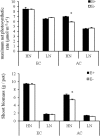
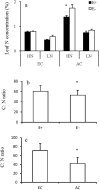
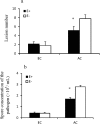
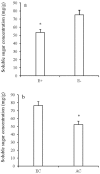

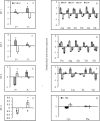

Similar articles
-
Does fungal endophyte infection improve tall fescue's growth response to fire and water limitation?PLoS One. 2014 Jan 31;9(1):e86904. doi: 10.1371/journal.pone.0086904. eCollection 2014. PLoS One. 2014. PMID: 24497994 Free PMC article.
-
Neotyphodium coenophialum-infected tall fescue and its potential application in the phytoremediation of saline soils.Int J Phytoremediation. 2014;16(3):235-46. doi: 10.1080/15226514.2013.773275. Int J Phytoremediation. 2014. PMID: 24912220
-
Metabolite analysis of the effects of elevated CO2 and nitrogen fertilization on the association between tall fescue (Schedonorus arundinaceus) and its fungal symbiont Neotyphodium coenophialum.Plant Cell Environ. 2014 Jan;37(1):204-12. doi: 10.1111/pce.12146. Epub 2013 Jul 2. Plant Cell Environ. 2014. PMID: 23742115
-
Novel endophyte-infected tall fescue for growing beef cattle.J Anim Sci. 2004;82 E-Suppl:E75-82. doi: 10.2527/2004.8213_supplE75x. J Anim Sci. 2004. PMID: 15471817 Review.
-
BILL E. KUNKLE INTERDISCIPLINARY BEEF SYMPOSIUM: Coping with tall fescue toxicosis: Solutions and realities.J Anim Sci. 2015 Dec;93(12):5487-95. doi: 10.2527/jas.2015-9229. J Anim Sci. 2015. PMID: 26641158 Review.
Cited by
-
The Plant Salicylic Acid Signalling Pathway Regulates the Infection of a Biotrophic Pathogen in Grasses Associated with an Epichloë Endophyte.J Fungi (Basel). 2021 Aug 4;7(8):633. doi: 10.3390/jof7080633. J Fungi (Basel). 2021. PMID: 34436172 Free PMC article.
-
Epichloë endophyte interacts with saline-alkali stress to alter root phosphorus-solubilizing fungal and bacterial communities in tall fescue.Front Microbiol. 2022 Dec 22;13:1027428. doi: 10.3389/fmicb.2022.1027428. eCollection 2022. Front Microbiol. 2022. PMID: 36620058 Free PMC article.
-
Epichloë Fungal Endophytes-From a Biological Curiosity in Wild Grasses to an Essential Component of Resilient High Performing Ryegrass and Fescue Pastures.J Fungi (Basel). 2020 Nov 27;6(4):322. doi: 10.3390/jof6040322. J Fungi (Basel). 2020. PMID: 33261217 Free PMC article. Review.
-
Antagonism to Plant Pathogens by Epichloë Fungal Endophytes-A Review.Plants (Basel). 2021 Sep 24;10(10):1997. doi: 10.3390/plants10101997. Plants (Basel). 2021. PMID: 34685806 Free PMC article. Review.
-
Global Change Factors Influence Plant-Epichloë Associations.J Fungi (Basel). 2023 Apr 6;9(4):446. doi: 10.3390/jof9040446. J Fungi (Basel). 2023. PMID: 37108902 Free PMC article. Review.
References
-
- IPCC. Climate Change 2013: The Physical Science Basis. Contribution of Working Group I to the Fifth Assessment Report of the Intergovernmental Panel on Climate Change (ed. by T. F. Stocker, D. Qin, G. K. Plattner, M. Tignor, S. K. Allen, J. Boschung, A. Nauels, Y. Xia, V. Bex and P. M. Midgley), pp. 148. Cambridge University Press, Cambridge, U. K. and New York, New York. doi:10.5061/dryad.56cn8015 10.1086/665032 (2013).
-
- Bryant JP, Chapin FS, Klein DR. Carbon/nutrient balance of boreal plants in relation to vertebrate herbivory. Oikos. 1983;40:357–368. doi: 10.2307/3544308. - DOI
Publication types
MeSH terms
Substances
LinkOut - more resources
Full Text Sources
Other Literature Sources

